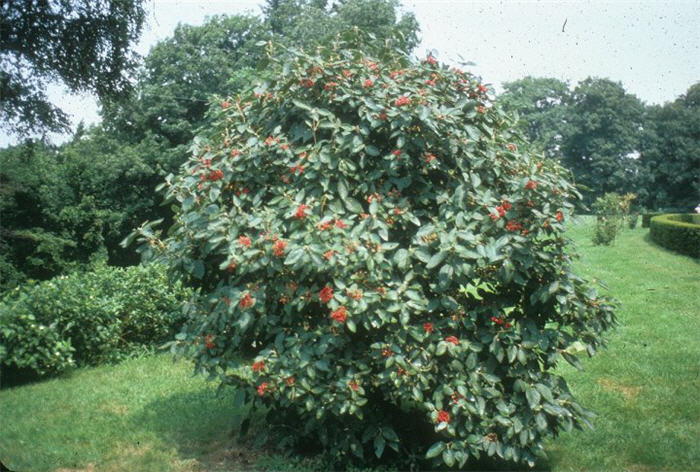| Botanical Name: Viburnum lantana | |
| Common Name: Wayfaringtree Viburnum |

-
Anatomy
-
Culture
-
Design
Plant Type
Shrub
Height Range
6-12'
Flower Color
White
Flower Season
Spring
Leaf Color
Dark Green
Bark Color
Brown, Grey
Fruit Color
Black, Red
Fruit Season
Fall, Persistent
Sun
Full, Half, Shade
Water
Low, Medium, Extra in Summer
Growth Rate
Moderate
Soil Type
Sandy, Clay, Loam, Rocky, Unparticular
Soil Condition
Average, Rich, Poor, Well-drained, Dry
Soil pH
Acid, Neutral, Basic
Adverse Factors
Invasive
Design Styles
English Cottage, Formal, Meadow, Mediterranean, Ranch, Spanish, Woodland
Accenting Features
Fall Color, Showy Flowers
Seasonal Interest
Winter, Spring, Summer, Fall
Location Uses
Background, Shrub Border, Foundation, Parking Lot, Raised Planter, Walls / Fences
Special Uses
Hedge, Screen, Mass Planting
Attracts Wildlife
Birds, Butterflies
Information by: Stephanie Duer
Photographer: JJ Neilson Arboretum
Photographer: JJ Neilson Arboretum
-
Description
-
Notes
Wayfaringtree is a deciduous viburnum with an upright, rounded though erect, multi-stemmed habit, growing to 10 to 15 feet tall and 8 to 10 feet wide. It has large, simple softly grey-green leaves that are sort of crinkly above and fuzzy underneath. Fall color is purplish-brown, with leaves persisting well into the fall. White flowers form clusters in May, and are followed by berries that ripen in late summer to fall, from red to blue-black. Berries are greatly enjoyed by birds. Bark is a warm grey, and though possessing no special attributes, is has a lovely winter silhouette and its density provides some winter screening. 'Mohican' is a commonly available cultivar growing 8 to 10 feet tall and slightly narrower, though have seen it taller.
Grow in well drained soil in full sun to part shade, though it will grow on the north side of a building if it receives some summer sun. Is very adaptive to soil types, including compacted soils, clay soils, and poor soils; will grow in dry shade areas. Tolerant of higher pH than is typical of viburnum (probably comparable to V. rhytidophylloides). slowly suckering habit makes it useful for moderate erosion control. Attracts birds and butterflies. Is sometimes bothered with leaf spot disease, though this can usually be avoided by not over watering and not overhead-watering. A tough, durable, and attractive shrub.